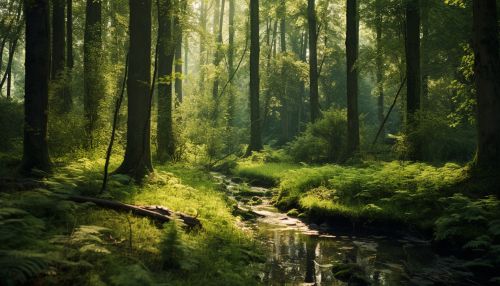Temperate Forest
Introduction
A temperate forest is a type of forest found in regions with a temperate climate, characterized by its four distinct seasons: spring, summer, autumn, and winter. The term "temperate" refers to the moderate or mild nature of the climate in these regions, which is neither extremely hot nor extremely cold. Temperate forests are one of the richest and most diverse ecosystems on the planet, housing a wide variety of plant and animal species.


Distribution and Types
Temperate forests are found in several regions around the world, including North America, Europe, East Asia, and parts of South America and Australia. There are several types of temperate forests, each with its own unique characteristics and species composition. These include:
- Deciduous Forests: These forests are dominated by deciduous trees, which shed their leaves annually. They are found in regions with a moderate amount of precipitation and a wide range of temperatures.
- Mixed Forests: These forests contain a mix of deciduous and coniferous trees. They are typically found in regions with a moderate climate, with a balance of rainfall and temperature.
- Temperate Rainforests: These forests are characterized by a high amount of rainfall and a mild climate. They are typically dominated by coniferous trees and are found in regions like the Pacific Northwest of North America.
Climate
The climate in temperate forests is moderate, with four distinct seasons. The average annual temperature is typically between 0°C (32°F) and 20°C (68°F), with significant temperature variation between seasons. Precipitation is evenly distributed throughout the year, ranging from 500 to 2000 mm annually. The summer season is typically warm and wet, while the winter season is cool and dry.
Flora and Fauna
Temperate forests are home to a diverse range of plant and animal species. The flora in these forests varies greatly depending on the type of forest and its location. Deciduous forests, for example, are dominated by tree species such as oak, maple, and birch, while coniferous trees like pine, fir, and spruce dominate in temperate rainforests.
The fauna in temperate forests is equally diverse, with a wide range of mammals, birds, reptiles, and insects. Common mammal species include deer, bears, and squirrels, while birds such as owls, eagles, and songbirds are also prevalent. Insects, amphibians, and reptiles also make up a significant portion of the biodiversity in these forests.
Ecological Importance
Temperate forests play a crucial role in the global ecosystem. They act as carbon sinks, absorbing CO2 from the atmosphere and helping to mitigate climate change. They also play a vital role in the water cycle, helping to regulate water flow and maintain water quality.
Furthermore, these forests are a hotspot for biodiversity, providing habitat for a wide range of species. They also provide essential ecosystem services, such as pollination, pest control, and soil formation.
Threats and Conservation
Despite their ecological importance, temperate forests are under threat from various human activities. Deforestation, primarily for agriculture and urban development, is one of the biggest threats to these ecosystems. Climate change also poses a significant threat, as changes in temperature and precipitation patterns can disrupt the delicate balance of these ecosystems.
Conservation efforts are crucial to protect and preserve temperate forests. This includes establishing protected areas, implementing sustainable forestry practices, and promoting awareness about the importance of these ecosystems.
